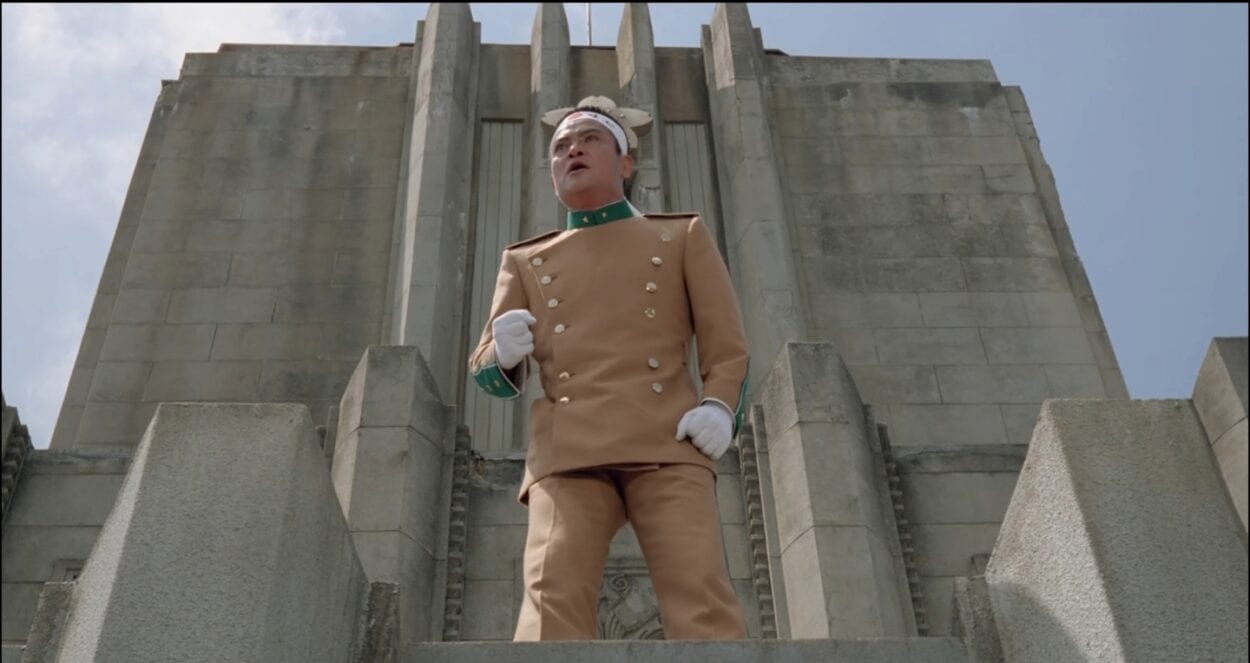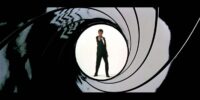Feature films that are based around a real-life figure can be tackled in a variety of methods and manners to portray a unique artistic version of a non-fictional person or group of people. The actor or actress portraying the figure can be cast as close to the real-life appearance and mannerisms of the real-life figure in a film (Capote, 2005) or be wildly different in age and racial ethnicity (I’m Not There, 2007), and the film can be a precise retelling of the figure’s life (The Aviator, 2004) or a loose take on the real-life history of the central character (Naked Lunch, 1991). In Paul Schrader’s masterful film Mishima: A Life in Four Chapters (1985), Schrader takes a unique middle-ground in retelling the real-life figure of Japanese writer and poet Yukio Mishima while adapting scenes from three of his central works to tie into the overall characteristics and mannerisms of the ever-present Mishima character. By showcasing the varied three works of literature written by Mishima that connect to his life and the differing soundtrack arrangments by Philip Glass that evolve between flashbacks, present-day, and literary adaptations, Schrader creates a biopic that expresses the importance of artists by reflecting the various points of life experience and personal beliefs that the artist holds within their works.
The film starts in the present-day of November 25, 1970, after a title card that explained the importance of Yukio Mishima’s work in Japanese society through his massive body of work and the popularity achieved in his home country, where he and his followers would soon begin to attempt a coup. Mishima (Ken Ogata) wakes up in his bed and begins the day in his empty mansion, while his wife is gone to take their children to school. He begins to dress up in his military commander uniform and packs a briefcase filled with writings and a couple of small swords. He talks over the phone to bring a photographer to the Eastern Army Headquarters and sends a sealed envelope to a media outlet. As Mishima heads out of his home, the camera shifts from him to a window where the audience views a black and white flashback scene narrated by the adult Mishima as he describes his childhood in the care of his grandmother. Mishima is seen being kept from the outside world by his grandmother, claiming that he is a delicate plant and that he would die if his mother took care of him instead of herself. This controlling relationship can be referred to as the overall plot of Mishima’s novel Kyoko’s House, which details the sadomasochistic relationship between a young man, Osamu, and a controlling middle-aged woman, hinting at the hidden desire for a master/subject relationship seen within his loyalty to the emperor of Japan that leads to his downfall, just as the main character in Kyoko’s House experiences while getting his mother out of a debt from a criminal gang leader by being controlled by her. This also ties into Mishima’s sexual fascination towards good-looking men within the film, as the main female role model during most of his adolescence was frail, elderly, and an overall representation of Mishima’s stated fear later in the film that men older than forty years of age could never die beautifully, just as the beauty-obsessed Osamu of Kyoko’s House doesn’t feel any romantic attraction to his female master because of her older and less-appealing looks.
 During this childhood flashback scene, Mishima is shown to be an outcast and ridiculed by his classmates for being seen as subservient to his mom, which leads to him vocally stuttering. Suddenly, the audience is placed into the first adaptation sequence of Mishima’s novel The Temple of The Golden Pavillion, where the main character, Mizoguchi, is a young Buddhist acolyte that suffers from heavy speech stuttering. While at the Pavillion, Mizoguchi begins to become acquainted with a Buddhist acolyte named Kashiwagi, who has a physical disability, and tells Mizoguchi that they both can have sex with women near the Pavillion through pity.
During this childhood flashback scene, Mishima is shown to be an outcast and ridiculed by his classmates for being seen as subservient to his mom, which leads to him vocally stuttering. Suddenly, the audience is placed into the first adaptation sequence of Mishima’s novel The Temple of The Golden Pavillion, where the main character, Mizoguchi, is a young Buddhist acolyte that suffers from heavy speech stuttering. While at the Pavillion, Mizoguchi begins to become acquainted with a Buddhist acolyte named Kashiwagi, who has a physical disability, and tells Mizoguchi that they both can have sex with women near the Pavillion through pity.
As Mizoguchi fails to follow through having sex with a woman after she learns of his speech problem due to his mind being distracted by the beautiful image of the Pavillion, Mizoguchi hopes that American bombers will destroy the Pavillion, but is later disheartened when America wins the war without destroying the Pavillion, a symbol of unattainable beauty that Mizoguchi believes doesn’t belong in the world and eventually sets it on fire himself. This novel sequence ties into the adult worry that Mishima wrote about his own appearance later in the movie and how he believed the beauty of the human body deserved to be idolized in art, and that old age prevents all men from being kept beautiful in death. This act of destruction also allows Mizoguchi to be free of his worries as he takes power in his own hands to enact destruction since outside forces like the Americans couldn’t help him, further reinforcing Mishima’s adoration into taking personal control of life since others are weak or incapable of enacting those desires, an ideal which Mishima would explore heavily and be the eventual catalyst for his death.
This shifting between black and white flashbacks, contemporary 1970s Japan, and novel adaptation is further accentuated with the changing musical style of Philip Glass’s orchestral score throughout the entire film. With art and personal life being connected multiple times within the film between Mishima’s experiences and the ideals he believed that was tied into his art based on those experiences, the various facets of Mishima’s life prevail through the bombastic and highly expressive score. Just as the directing style changes between naturalistic contemporary scenes, somewhat realistic flashback sequences, and highly stylized and theater-inspired set designs of the novel adaptations, the score undergoes drastic evolutions between string and percussion, only string, and full orchestral score respectively. This ever-changing musical style pairs well with the ever-evolving life of the central Mishima character and the art he made, allowing Glass’s majestic score to punctuate the necessity of change throughout life.
After avoiding service in the second world war by faking tuberculosis, Mishima started to develop popularity over time. While gaining popularity through his works, Mishima has a hidden homosexual relationship with another man, despite feeling insecure about his own body. Going through Greece, Mishima starts to become enamored with bodybuilding as a result of Greek statues that showcased the male physique; an artistic ideal that affected him even as a youth when he saw the image of a beautiful St. Sebastion tied onto a tree and shot with arrows and would later recreate as an adult during various photoshoots. These scenes are shot with such reverence and closeness towards the male physique that it accurately reflects the adoration Mishima held towards the male body and physical labor which results in good health. The photoshoots also allow the audience to view the often societal male figures like handgun-holding outlaws and assassins of middle aga-era Japan that Mishima appreciates, whose roles in Japanese society began to fade with the ever-increasing technological economies and focus on businessmen instead of symbols of a bygone age for which the traditionalistic Mishima would dislike. Mishima then starts a personal military and his constant admiration for the emperor of Japan becomes a source of contention for leftist students in Japan, despite also hating the modernization and capitalistic leaders of Japan as well. Where the students are shown to be rowdy and numerous, Mishima’s army is shown in such well-maintained marches and orderly that the contrast between Mishima’s militaristic mannerisms is at extreme visual odds with the students that despise the controlling system that organizations like the military represents. This then leads into the final novel adaptation scene with Runaway Horses, the most startlingly prescient work that almost predicts exactly how Mishima would soon die.
The main conflict of Runaway Horses is that a group of young fencers is lead by Isao, their best team member, to committing a series of assassinations against economic and capitalist leaders to restore the emperor in Japan before committing Seppuku and dying. As the young man tries to work with an army insider that eventually abandons them when he’s transferred out of the country and then the conspiracy is apprehended by the police after staying with him despite no outside help, the man enters the house of a wealthy man named Kurahara, who Isao stated the would kill as the primary target prior to his arrest, and kills him before escaping to seaside cliffs and commits seppuku in front of a rising sun over the horizon. This act of political upheaval and a violent death despite the lack of any additional support couples strongly with Mishima’s pride in the strength of an individual despite an overbearing outside force which he viewed as a threat to his country of Japan. And, the self-sacrificial nature of the novel tied into the highly regarded ideals of a young death and symbolic freedom against an imposing world for which Mishima despised through his works of art in the film. The death of Isao within the novel is also highly revered by Mishima as his body is bathed in the warm glow of the rising sun over an endless landscape of unobstructed freedom, compared to the controlling and shut off nature of the prison and Kurahara’s house.

This finally leads to the conclusion of the film as Mishima and a group of his soldiers storm the offices of the Eastern Army Headquarters and subdue the general in a barricaded office room to try and raise a military coup to restore the emperor of Japan. Mishima then steps onto the balcony but is ridiculed by the audience of Japanese soldiers below and is shouted off the balcony after they fail to listen to him with helicopters flying around. Mishima then realizes that death is the goal for himself as he flew previously in a jet and was astounded by the lifelessness of the upper atmosphere, and decides to commit Seppuku. With Mishima’s demise, the cycle of death and destruction is complete throughout all of his previously adapted works and is the great equalizer for Mishima’s art and life itself. With the unseen sword going through Mishima’s stomach, the film’s score explodes in a sort of celebratory act as this was the outcome Mishima idolized in terms of a younger death and never succumbing to the pressures of outside forces. The Pavillion burns, Osamu is dead with his master, and Isao is bleeding profusely over the cliffs of Japan, but while Mishima has been gone for a long time, the art he created was made lifeless through his controversial and violent act of defiance in a world that Mishima was left behind by.



